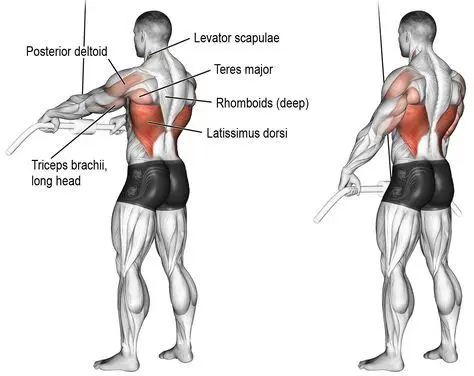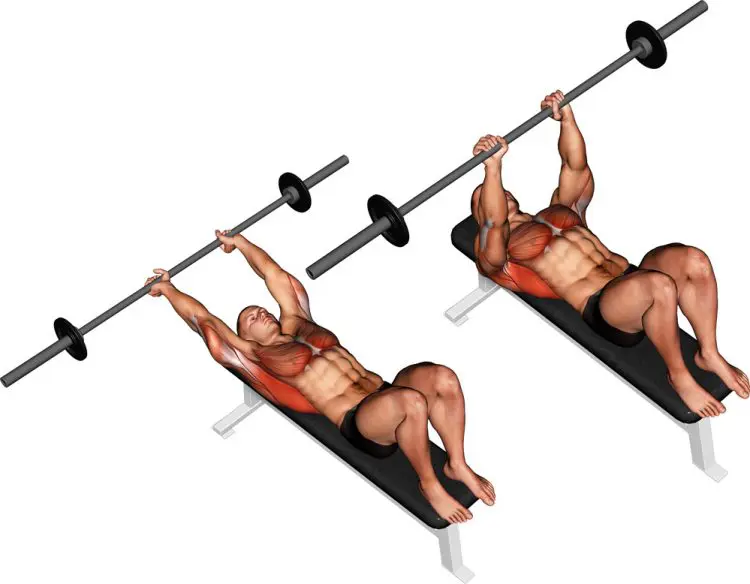The cable incline pulldown is a back exercise variation that emphasizes the latissimus dorsi or simply lats for short. It’s not an exercise that you see performed often in your local gym, and you may not do it yourself. However, that doesn’t mean it’s any less effective than other similar variations.
Aside from developing the lat muscles, it’s one of the best movements for improving scapular strength and stability. This is an essential component of safely and effectively performing any compound exercise with proper form and posture.
Today, we’re going to explain how to do this exercise, offer some key tips, variations, and provide an example of how to include it in your back training routine.
Here’s a guide to the cable incline pushdown…
Muscles Worked
The cable incline pushdown engages several muscles that assist during this exercise.
Latissimus Dorsi
Because the incline pushdown should mimic a pullover or straight arm pushdown it’s going to primarily target the lat muscles. Although it will still include all of the other back muscles as well. The lats are a large scapular muscle that move the arm at the shoulder in various directions.
Level Up Your Fitness: Join our 💪 strong community in Fitness Volt Newsletter. Get daily inspiration, expert-backed workouts, nutrition tips, the latest in strength sports, and the support you need to reach your goals. Subscribe for free!
Deltoid Posterior
Included in the posterior group of muscles, the rear deltoids on the back of the shoulder push the scapula back into a retracted position.
Pectoralis Major Sternal Head
You’ll also feel the chest contracting during incline pushdowns as the lower chest fibers draw the arms downwards.
Teres Major
The teres major resides on the upper back above the lats and is planted down onto both the humerus and scapula. It provides extension and medial rotation of the upper arm and is not a rotator cuff muscles like the teres minor.
How To Do The Cable Incline Pushdown
Here are step-by-step instructions for how to properly execute the cable incline pushdown.
- Place the bench next to the cable machine so that your head will be close to the pulley as shown in the video, and adjust it to about a 45-degree incline.
- Set the pulley with the bar attached low enough to where you can grab it comfortably but high enough to where you’re able to maintain tension in the cable while seated with arms extended overhead.
- Grasp the bar with hands about shoulder-width apart, keep your shoulders back, chest up, and engage your lats.
- With your elbows just slightly bent, drive your elbows down until your arms are at torso level.
- Raise your arms back up slowly until they’re almost extended overhead and repeat the exercise for the desired reps.
Here’s a video example…
Cable Incline Pushdown Tips
- Always use a weight that you can handle for at least 6-8 reps with good form. Anything heavier and you’re not maximizing the movement, by compromising proper form.
- Do not set up the pulley too high or low. Set it up just low enough that allows you to get full extension of the arms overhead. This simply makes things easier especially when you have to release the weight at the end of the set.
- You can also use an EZ bar or rope to perform this exercise.
Cable Incline Pushdown Variations
While the cable incline pushdown is a great variation, there are other movements that don’t involve as much setup but that also works extremely well for developing the lats and scapular strength and stability.
1. Straight-arm pushdown
The straight-arm pushdown is the most commonly-used variation. It’s easiest to set up and perform and is the perfect choice for including in supersets due for this reason. It’ll still work the same muscles and function and we definitely recommend including it into your routine.
Level Up Your Fitness: Join our 💪 strong community in Fitness Volt Newsletter. Get daily inspiration, expert-backed workouts, nutrition tips, the latest in strength sports, and the support you need to reach your goals. Subscribe for free!
2. Barbell pullover
The barbell pullover is a lying variation that is often utilized to develop the lat muscles. There are several variations of this variation, and we also recommended utilizing the bent-arm decline version that offers an advantage in that you’re able to better keep tension on the muscle.
3. Machine lat pullover
The machine lat pullover offers an advantage over other variations because you’re locked in and can focus solely on the movement without having to stabilize or focus on any other aspect of the exercise. Of course, you’ll still need to maintain proper body positioning by engaging the lats and keeping the chest up to maximize this exercise.
There are different types of machines so you’ll need to learn how to use the one you have access too.
How To Incorporate The Cable Incline Pushdown Into Your Training Routine
There are a few ways to include the cable incline pushdown into your training regime.
It’s a good idea to perform a set of this exercise before and in between your deadlifts. That’s because it reminds you to maintain proper scapular positioning which is crucial during the deadlift. So for example, you’ll do a set before you do your first set of deadlifts, and then you’ll perform a set in between your deadlift sets.
Another common way to include it is after your heavy back training movements. So for example, you’ll perform your deadlifts, rows, etc, and then incorporate the cable incline pushdown at the end to finish things off.
Sets/Reps
This depends on your overall training volume, but, in general, we recommend doing 3-4 sets x 10-12 reps.
Focus on your form and progress week by week, by aiming to add a little more weight and/or by completing more repetitions, all while sticking with the recommended rep range for most of your sessions.
Wrapping Up
The cable incline pushdown is an excellent variation of an essential movement that has lots of carryover to the bigger compound, multi-joint lifts. Not only does it build the lat muscles, but it develops scapular stability and strength and is a good teaching exercise for maintaining proper posture during your bigger movements.
We hope that this exercise was helpful and we’re confident that you now have the knowledge to be able to effectively include this movement in your training movement.
Interested in measuring your progress? Check out our strength standards for Deadlift, Bent Arm Barbell Pullover, Barbell Pullover, and more.










